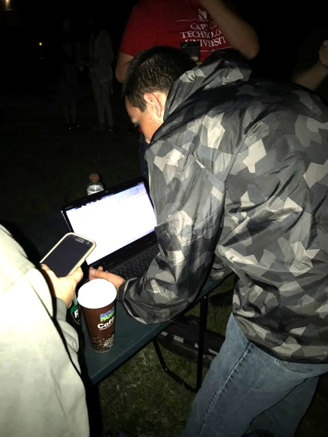How to control a satellite with your mobile phone? Capitol students prove it is possible
April 11, 2018On any given day, each of us will put our smart phone to a myriad of uses. We may use it to shop. Communicate with colleagues, friends, and family. Check the weather ahead of a plane trip. Monitor stocks. Track our daily exercise routine. Check out the latest track from our favorite artist.
How about using your mobile phone to command and control a satellite in orbit high above the earth?
Not only is it possible in theory, but a group of Capitol students has devised a practical way to put it into practice. The students’ endeavor – dubbed Project Hermes – has attracted attention from space scientists and engineers, along with coverage in media outlets such asThe Baltimore Sun.
“I thought it was very clever and inventive on their part,” The Sun quoted David Kusinerkiewicz, chief engineer at John Hopkins University’s Applied Physics Laboratory (APL), as saying. “I can picture somebody sitting in a Starbucks on their smartphone talking to their satellite and getting data back. It’s a pretty cool concept.”
And the concept has been tested. In 2015, Project Hermes enjoyed its first successful space flight aboard a NASA rocket. Team members waited expectantly – then exulted as letters appeared on their cell phones, sent by the payload high overhead. The concept was tested again, with successful results, at NASA’s RockSat-X program in the summer of 2017.
Now another momentous milestone awaits: going into orbit. Integrated into a combined Capitol satellite project known as Cactus-1, Hermes was selected for NASA’s CubeSat Launch Initiative (CSLI), with lift-off expected in the coming months.
Real-time interaction using mobile devices has the potential to transform satellite operations, says Capitol professor Risabh Maharaja, whose idea – presented during his Introduction to Space class – was the genesis of Hermes, with students then developing a way to put it into practice.
Currently, he notes, operations are limited by a satellite’s footprint; commands can only be given, or telemetry received, when a “bird” is within view either of a ground station or relay satellite. The Hermes approach, which utilizes the Iridium constellation of interlinked communications satellites, changes all that. Mission control “could maintain communication using commercial satellites with ordinary internet TCP/IP, with potentially higher bandwidth and quicker response times than conventional methods," Maharaja explains.
Hermes is only one example of the hands-on engineering projects that Capitol students become involved with from their first year at the university. The school’s educational approach stresses immersion in practical projects from year one – a philosophy that distinguishes Capitol from many other colleges and universities, where students do not gain such exposure until their junior or senior years.
Other student-led projects at Capitol include TRAPSat, which is exploring a method of capturing space debris using Aerogel, and Project Aether, which is investigating auroral effects on the atmosphere while also testing new insulation system and comparing data rates from multiple sources.
Gaining such practical experience is a major asset for aspiring space systems engineers as they prepare for a career in the industry, students say.
“Everything that we’re doing here benefits the students and is helping us look better when we go out into the job market,” says Hermes flight software specialist Christopher Murray. “Not many people in a job interview can honestly say that they have participated in designing a payload that went up into space.”
Dream of a career working with rockets, satellites, and space? With a Capitol degree, the dream is within reach. Find out more about our unique program in astronautical engineering, or contact admissions@captechu.edu



